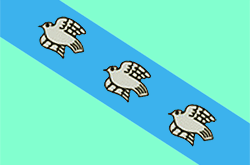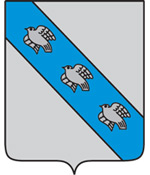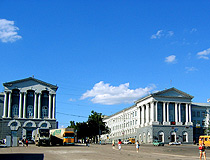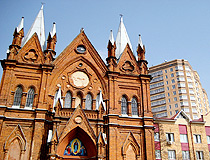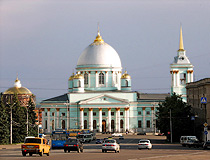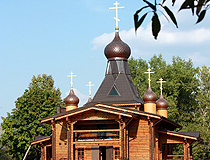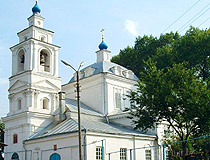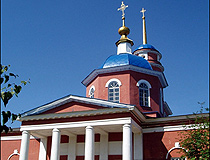History of Kursk
The first settlements on the territory of Kursk
About 20 thousand years ago, when a significant part of Europe was covered by the glacier, people already lived on the territory of present-day Kursk. They lived in dugouts and hunted mammoths. In the Neolithic era, about 12 thousand years ago, when the ice receded, the climate of the Kursk region changed and people began to settle more actively by the rivers. The settlements of ancient people of this era were found in some local villages and in Kursk itself.
In the Bronze Age, about 6 thousand years ago, people also began to engage in cattle breeding and agriculture. Bronze Age burials discovered in the center of Kursk date back to the 2nd millennium BC. In the early Iron Age, iron smelting began based on numerous deposits of iron ore.
From the 7th to the 5th centuries BC, fortified settlements appeared in the region. At that time, the first fortress was built at the mouth of the Tuskar and Kur rivers. It is possible that even 2,500 years ago this settlement had a name similar to the current one (Kursk). However, the first fortress did not last long; the population left it in connection with the Sarmatian invasion.
In the first half of the 1st millennium AD, tribes of the Chernyakhov culture lived in the northern part and in the west of the Kursk region. Later, the Huns led the Chernyakhov culture to decline, but did not destroy it. On the territory of the Kursk region, settlements of this culture lasted until the 5th-6th centuries AD.
More Historical Facts…
Foundation of Kursk
The official year of foundation of Kursk is 1032. It is mentioned in the chronicle “The Life of Theodosius of the Caves” written by Nestor the Chronicler in the 11th century. According to the results of archaeological excavations, it can be assumed that the Kursk fortress was founded in 982-984 and was located on the territory of present Krasnaya Square of Kursk. Since the end of the 11th century, it was one of the most powerful outposts on the border of Kievan Rus.
In 1238, the town was completely destroyed during the Mongol invasion. In the 1360s, the Lithuanian ruler Algirdas conquered the Kursk lands from the Mongols. After that, for almost 150 years, Kursk was part of the Grand Duchy of Lithuania.
Until the middle of the 15th century, Kursk was not mentioned in Russian chronicles. In 1508, it became part of the Russian state. Moscow princes began the restoration of Kursk as a fortified town. The threat from the Crimean Tatars slowed down the recovery process.
Almost a century after the accession of Kursk to the Moscow Principality, the town re-emerged in a new place (on two hills on the right bank of the Tuskar River, at the confluence with the Kur River). The date of the re-founding of Kursk is considered to be 1586. In 1596, a new fortress was constructed. In 1616, there were over 1.3 thousand people in the garrison of this fortress.
Kursk in the 17th-19th centuries
At the beginning of the 17th century, Polish-Lithuanian detachments (in 1612, 1616, 1617, 1634), Crimean Tatars, Nogais repeatedly attacked Kursk, but the fortress was never captured. In 1654, after the Khmelnytsky Uprising, the Russian border moved away from Kursk.
People from Oryol and other southern Russian towns were resettled to Kursk. In 1678, there were 2.8 thousand residents in the town. It developed because of its favorable geographical position (the shortest route from Moscow to Crimea, the road to Kiev). In the 17th century, not far from Kursk, the Korennaya Fair was opened, which quickly became one of the largest fairs in Russia. The role of Kursk in the country’s economy was continuously growing.
In 1779, the town received the status of a provincial center. In 1780, the emblem of Kursk was adopted, which depicted three flying partridges. After the great fire that devastated Kursk in 1781, a new master plan of the town was adopted. In 1785, there were 7,590 residents in Kursk. In 1797, the Kursk Governorate was formed. In the 18th century, Kursk became a major trading center and lost its borderline significance.
At the beginning of the 19th century, Kursk continued to develop not only as a commercial, but also an industrial center. The Moscow-Kursk railway was opened in 1868. By the end of the 19th century, about 40 thousand people lived in Kursk. The city became an important center of the food industry (flour and sugar production).
Kursk in the 20th century and beyond
In 1903, the Kursk Museum of Local Lore was opened. In the digest “The Cities of Russia in 1904”, it was said that 29,845 men and 26,743 women lived in Kursk. Of the 4,529 buildings, 967 were stone, 2,677 were wooden, 885 were mixed (stone and wood together). 1,392 workers were employed in 82 local factories.
At the end of 1917, Soviet power was established in Kursk. In March 1918, German troops invaded the territory of the Kursk Governorate. In November 1918, the troops of the German Empire left the region. From June to December 1919, during the Russian Civil War, part of the region was occupied by the Armed Forces of the South of Russia. In the process of rebuilding the economy after the Civil War, an exploration of the Kursk magnetic anomaly began.
In 1928, the Kursk Governorate was liquidated, its territories became part of the Central Black Earth Region. In 1934, it was divided into Voronezh and Kursk oblasts. Along with agriculture, industry developed in the region. New industries were created: chemical, textile, pharmaceutical, and heavy engineering. In early September 1934, the Kursk State Pedagogical Institute was opened, one year later - the Kursk State Medical Institute.
In 1939, the population of Kursk was about 120,000 people. During the Second World War, Kursk was occupied from November 3, 1941 to February 8, 1943, more than 70% of its enterprises were destroyed. The restoration of the city began immediately in February 1943. The Battle of Kursk (July 5, 1943 - August 23 1943) was one of the key land battles of the Second World War. The village of Prokhorovka, located near the city, became the place of one of the largest tank battles in history.
An important event for the Kursk industry was the launch of the Rubber Technical Products Plant in 1948 - one of the largest chemical enterprises in the USSR. By 1950, the urban economy was fully restored. Kursk gradually turned into a large industrial city. In 1959, the population of Kursk was 204,712 people. In 1982, Kursk celebrated its 950th anniversary.
In 1998, in honor of the 55th anniversary of the Battle of Kursk, the eponymous memorial complex was opened. On August 12, 2000, during the military exercise in the Barents Sea, the nuclear submarine “Kursk” sank. Eighteen crew members of this submarine were buried in Kursk. In 2007, Kursk was awarded the honorary title “The City of Military Glory”.
Architecture of Kursk
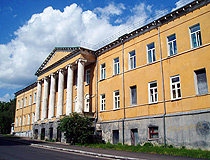
Kursk City Clinic #1
Author: Sarychev Sergei
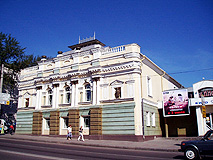
Movie theater named after Shchepkin in Kursk
Author: Sarychev Sergei
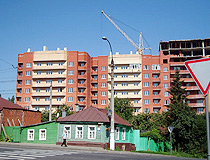
Construction of new apartment buildings in Kursk
Author: Sarychev Sergei
Kursk - Features
Kursk, located in the forest-steppe zone, is one of the most environmentally friendly large cities in Russia. In 2013, it was recognized as the most environmentally friendly large city in Russia according to the rating of the Ministry of Natural Resources and Ecology of the Russian Federation.
The climate of the city is temperate continental. Winters are moderately cold, although there are thaws, severe frosts are rare. Summers are unstable. Clear, hot weather is often replaced by cool, rainy. The average temperature in January is minus 7.2 degrees Celsius, in July - plus 21.5 degrees Celsius.
Kursk is a large industrial center. The city has a developed electrical industry, instrument-making and machine-tool industries, production of machinery and equipment for the agricultural sector, food and processing industries, production of commercial equipment, bearings and batteries, production of chemical fibers and rubber products, furniture, medicines, food stuffs, etc.
The Kursk magnetic anomaly, located in the Kursk and Belgorod regions, is the largest iron ore deposit on Earth.
This city is an important transport hub of central Russia. Two important railway lines pass through Kursk: Moscow - Kharkiv (Ukraine) and Voronezh - Kyiv (Ukraine). Vostochny airport offers regular flights to Moscow, St. Petersburg, Sochi. The roads of the city have access to the federal highways M2 “Crimea”, A144 (Kursk - Voronezh - Saratov), and R199 (Kursk - the border with Ukraine). City public transport is represented by buses, trolleybuses, trams, electric buses, and minibuses.
Kursk was named after the Kur River, on the banks of which it was founded. According to one of the local legends, it was named after partridges (“kuropatka” in Russian), abundantly found in this area. This legend is reflected on the arms of Kursk on which you can see three flying partridges. The City Day of Kursk is celebrated on the last Sunday of September.
Kursk is rich in architectural monuments of the 17th-19th century. Its central square, as in Moscow, is called Krasnaya (Red) Square.
Main Attractions of Kursk
The Battle of Kursk Memorial Complex - an alley opened to the 55th anniversary of the Battle of Kursk in 1998. Here you can see a monument to Marshal Georgy Zhukov, military equipment, the Church of St. George the Victorious. The central place of the memorial complex is occupied by the Triumphal Arch with an equestrian statue of George the Victorious with a spear in his hand. Pobedy Avenue.
Znamensky Cathedral (1816-1826) - a magnificent Orthodox church built in the center of Kursk in honor of the victory in the Patriotic War of 1812 (the French invasion of Russia). The church was constructed in the style of classicism with features of the Western European Renaissance. It is a monument of architecture of federal significance. Lunacharskogo Street, 4.
Sergiev Kazan Cathedral (1752-1778) - a church built in the style of the Elizabethan Baroque resembling a magnificent palace, a monument of architecture of federal significance. Maksima Gorkogo Street, 27.
Catholic Church of Our Lady of the Assumption (1896) - a picturesque building constructed in neo-Gothic style. The artist Kazimir Malevich, the creator of the famous “Black Square”, was married in this church. Marata Street, 31.
Kursk Regional Museum of Local Lore. In total, this museum has over 181 thousand exhibits including collections of beads, porcelain, weapons, numismatics, paintings, rare books, furniture, and costumes.
It is located in a building that is an architectural monument of the 19th century and has three main departments: the department of nature, the department of the history of the pre-revolutionary period, and also the department of the history of Soviet society. Lunacharskogo Street, 6.
Kursk Museum of Archeology. This museum is located in the only preserved secular building of the mid-18th century in Kursk, constructed in the architectural style of Moscow Russia of the 16th-18th centuries (the house of the merchant Khloponin). The museum has ancient tools, ceramics, jewelry, sculptures, weapons, household utensils, coins. Pionerov Street, 6.
Kursk Art Gallery named after Aleksandr Deyneka. The collection of this art museum has more than 8,000 works of Russian and Western European art of the 16th-20th centuries, including paintings, sculptures, graphics, decorative and folk art. The collection of works created by the artist Aleksandr Deyneka, who was born in Kursk, is also of great interest. Radishcheva Street, 85.
The building of the Noble Assembly (1877) - a three-story red and white brick building constructed in the eclectic style in the center of Kursk, a monument of architecture of federal significance. This is one of the most picturesque buildings in Kursk. It houses the Military History Museum of the Battle of Kursk. Sonina Street, 4.
Kursk also has a drama theater, a puppet theater, a circus, a philharmonic society, and a planetarium.


